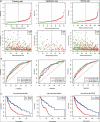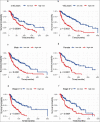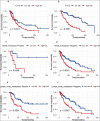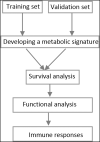A new metabolic signature contributes to disease progression and predicts worse survival in melanoma
- PMID: 33084485
- PMCID: PMC8291831
- DOI: 10.1080/21655979.2020.1822714
A new metabolic signature contributes to disease progression and predicts worse survival in melanoma
Abstract
Metabolic reprogramming is a common hallmark of tumor cells and is a crucial mediator of resistance toward anticancer therapies. The pattern of a metabolism-related signature in melanoma remains unknown. Here, we explored the role of a multi-metabolism-related gene signature in melanoma.We used the training and validation sets to develop a multi-metabolism-related gene signature. Cox regression analysis and the least absolute shrinkage and selection operator (LASSO) method were used for constructing a model. The predictive role of the metabolic signature with clinicopathological features of melanoma was also analyzed. Functional analysis of this metabolic signature was also investigated.A ten metabolism-related gene signature was identified and can stratify melanoma into high- and low- risk groups. The signature was correlated with progressive T stage, Breslow thickness, Clark level, and worse survival (all Ps< 0.01). This metabolic signature was shown as an independent prognostic factor and was also a predictive indicator for worse survival in various clinical and molecular features of melanoma. Furthermore, the metabolic signature was implicated in immune responses such as the regulation of T cell activation and cytokine activity. The metabolic signaturewas associated with the progression and worse survival of melanoma. Our study offered a valuable metabolism-targeted therapy approach for melanoma.
Keywords: Metabolism; immune; melanoma; prognosis; progression.
Conflict of interest statement
All the authors declare that they have no conflict of interest.
Figures







Similar articles
-
Melanoma long non-coding RNA signature predicts prognostic survival and directs clinical risk-specific treatments.J Dermatol Sci. 2017 Mar;85(3):226-234. doi: 10.1016/j.jdermsci.2016.12.006. Epub 2016 Dec 5. J Dermatol Sci. 2017. PMID: 27955882
-
A novel immune checkpoint-related seven-gene signature for predicting prognosis and immunotherapy response in melanoma.Int Immunopharmacol. 2020 Oct;87:106821. doi: 10.1016/j.intimp.2020.106821. Epub 2020 Jul 27. Int Immunopharmacol. 2020. PMID: 32731180
-
Predicting the clinical outcome of melanoma using an immune-related gene pairs signature.PLoS One. 2020 Oct 8;15(10):e0240331. doi: 10.1371/journal.pone.0240331. eCollection 2020. PLoS One. 2020. PMID: 33031392 Free PMC article.
-
Development and Validation of a CD8+ T Cell Infiltration-Related Signature for Melanoma Patients.Front Immunol. 2021 May 10;12:659444. doi: 10.3389/fimmu.2021.659444. eCollection 2021. Front Immunol. 2021. PMID: 34040608 Free PMC article.
-
Development and validation of a metabolic gene signature for predicting overall survival in patients with colon cancer.Clin Exp Med. 2020 Nov;20(4):535-544. doi: 10.1007/s10238-020-00652-1. Epub 2020 Aug 8. Clin Exp Med. 2020. PMID: 32772211
Cited by
-
Comprehensive Analysis of Monocarboxylate Transporter 4 (MCT4) expression in breast cancer prognosis and immune infiltration via integrated bioinformatics analysis.Bioengineered. 2021 Dec;12(1):3850-3863. doi: 10.1080/21655979.2021.1951928. Bioengineered. 2021. PMID: 34269158 Free PMC article.
-
Transcriptome Analyses Identify a Metabolic Gene Signature Indicative of Antitumor Immunosuppression of EGFR Wild Type Lung Cancers With Low PD-L1 Expression.Front Oncol. 2021 Sep 14;11:643503. doi: 10.3389/fonc.2021.643503. eCollection 2021. Front Oncol. 2021. PMID: 34595103 Free PMC article.
-
Identification of TYR, TYRP1, DCT and LARP7 as related biomarkers and immune infiltration characteristics of vitiligo via comprehensive strategies.Bioengineered. 2021 Dec;12(1):2214-2227. doi: 10.1080/21655979.2021.1933743. Bioengineered. 2021. PMID: 34107850 Free PMC article.
-
Overcoming chemoresistance to b-raf inhibitor in melanoma via targeted inhibition of phosphoenolpyruvate carboxykinase1 using 3-mercaptopropionic acid.Bioengineered. 2022 May;13(5):13571-13586. doi: 10.1080/21655979.2022.2080385. Bioengineered. 2022. PMID: 36700470 Free PMC article.
-
Novel natural inhibitors targeting B-RAF(V600E) by computational study.Bioengineered. 2021 Dec;12(1):2970-2983. doi: 10.1080/21655979.2021.1943113. Bioengineered. 2021. PMID: 34252351 Free PMC article.
References
-
- Bray F, Ferlay J, Soerjomataram I, et al. Global cancer statistics 2018: GLOBOCAN estimates of incidence and mortality worldwide for 36 cancers in 185 countries. CA Cancer J Clin. 2018;68(6):394–424. - PubMed
-
- Napolitano S, Brancaccio G, Argenziano G, et al. It is finally time for adjuvant therapy in melanoma. Cancer Treat Rev. 2018;69:101–111. - PubMed
-
- Madjd Z, Erfani E, Gheytanchi E, et al. Expression of CD133 cancer stem cell marker in melanoma: a systematic review and meta-analysis. Int J Biol Markers. 2016;31(2):e118–25. - PubMed
-
- Rozeman EA, Dekker TJA, Haanen J, et al. Advanced melanoma: current treatment options, biomarkers, and future perspectives. Am J Clin Dermatol. 2018;19(3):303–317. - PubMed
-
- Lim SY, Menzies AM, Rizos H.. Mechanisms and strategies to overcome resistance to molecularly targeted therapy for melanoma. Cancer. 2017;123(S11):2118–2129. - PubMed
Publication types
MeSH terms
Substances
LinkOut - more resources
Full Text Sources
Other Literature Sources
Medical
